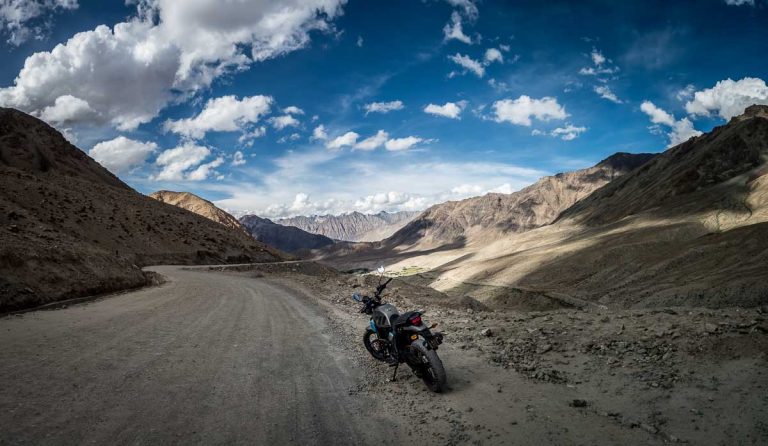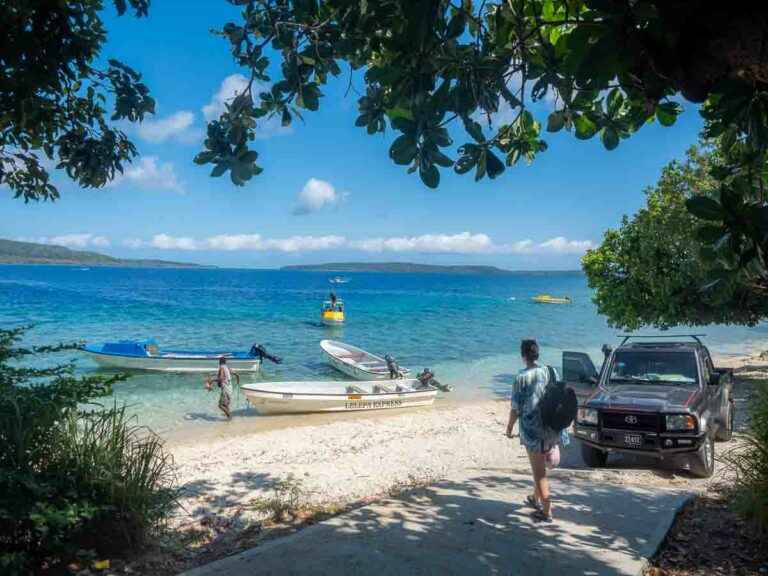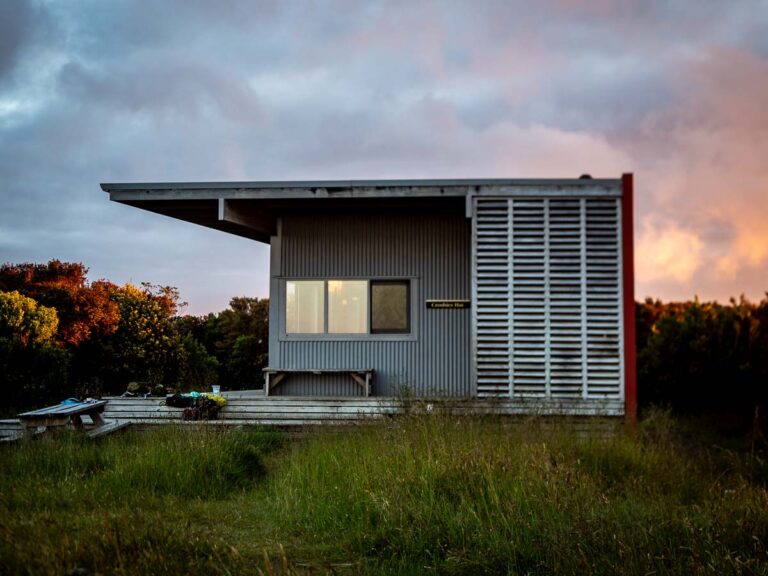The Tongariro Northern Circuit Hike (My Complete Guide)
I’ve now hiked most (not quite all) of New Zealand’s great walks and surprisingly one of my favorites has been the Tongariro Northern Circuit – so much so that I’ve done it twice!
The Northern Circuit is a 43.1 km (26.8 miles) trek through the stunning volcanic landscapes of Tongariro National Park, circumnavigating Mount Ngauruhoe and completing a section of the famous Tongariro alpine crossing. It typically takes 4 days, 3 nights, but can be made shorter if you’re that way inclined.
In this blog post, I will share my complete guide to hiking the Tongariro Northern Circuit, including my personal experience, essential information, and tips for a successful trip.
Table of Contents
Is Tongariro Northern Circuit Worth It?
The Tongariro Northern Circuit is undoubtedly one of the most iconic hikes in New Zealand, offering breathtaking views of volcanic craters, emerald lakes, and alpine vistas. If you’ve got 4 days in the central north island, i’d 100% recommend it.
Compared To Other Great Walks:
Compared to other great walks, such as the Milford Track or the Kepler Track, the Tongariro Northern Circuit is shorter and less physically demanding, making it an ideal option for intermediate hikers. However, it is still a challenging hike that requires good fitness, proper equipment, and careful planning.
I’ve learned better than to rank the great walks, but I’ll say I was pleasantly surprised by how good the Tongariro circuit was.
Compared to the Tongariro Alipine Crossing
If you are debating between the Tongariro Northern Circuit and the Tongariro Alpine Crossing, keep in mind that they are not the same hike. The Tongariro Alpine Crossing is a one-day trek that covers 19.4 km (12 miles) and is known for its stunning views of Mount Ngauruhoe (also known as Mount Doom in the Lord of the Rings movies). The Tongariro Northern Circuit, on the other hand, is a multi-day hike that includes the Tongariro Alpine Crossing as well as other scenic sections of the park.
If you’ve only got a short amount of time I’d do the crossing as this is the most spectacular part of the trail, but if you can afford 3 or 4 days the circuit is well worth it. Being able to camp up on the mountainside and experience the sunrises and sunsets on the mountain is something worth taking time for.

Where Does the Tongariro Northern Circuit Start?
The Tongariro Northern Circuit is a 43km loop track that starts and ends at the Whakapapa Village, located in the heart of Tongariro National Park. The village is easily accessible by car, bus, or shuttle from major cities such as Auckland or Wellington. If you are driving, you can park your car at the Whakapapa Visitor Centre, which offers long-term parking for hikers.
The Mythology
According to Maori mythology, Mount Tongariro is a sacred mountain located in the central North Island of New Zealand. The mountain is believed to have been created by the god of fire, Ngatoroirangi, who climbed to the top of the mountain and called upon his sisters, the goddesses of the winds and rain, to help him clear the way for his people to settle in the area.
Another legend surrounding the mountain tells the story of Tongariro, a chief who fell in love with a beautiful woman named Pihanga. However, Tongariro was also desired by another woman, Taranaki, who became jealous and attacked Tongariro, causing a great battle that resulted in the formation of the surrounding landscape, including the mountains and lakes.
The mountain is also associated with the Maori goddess of the underworld, Hinenuitepo, and it is believed that her spirit resides within the mountain. As a result, the mountain is considered a sacred site, and its presence must be respected and honored by those who visit the area.
Getting There
By Car
If you are coming from Auckland, the easiest way to reach Tongariro National Park is to drive south on State Highway 1 for approximately 4.5 hours. Alternatively, you can take a bus or shuttle from Auckland to Taupo, a lakeside town located 1.5 hours away from the park. From Taupo, you can take another shuttle or bus to the Whakapapa Village.
By Train
One thing I didn’t realize until I met a couple of Americans who had done just this is getting there by train!
The main trunk line runs from Auckland down to National Park annd, from there, take a shuttle to Whakapapa village or Hitchhike.
Click here for more information and bookings.
How Long is the Tongariro Northern Circuit? The Options
The Tongariro Northern Circuit can be completed in three different durations: 4 days/3 nights, 3 days/2 nights, or 2 days/1 night. The length of your hike will depend on your fitness level, hiking experience, and personal preferences.
| Hut | Distance from Previous Hut | Estimated Hiking Time |
|---|---|---|
| Whakapapa Village | – | – |
| Mangatepopo Hut | 9 km (5.6 mi) | 3-4 hours |
| Oturere Hut | 12.4 km (7.7 mi) | 5.5 hours |
| Waihohonu Hut | 7.5 km (4.7 mi) | 3 hours |
| Whakapapa Village | 14 km (8.7mi) | 4 hours (+1.5 if you go to Tama lakes) |

Option 1: 4 Days/3 Nights
The 4-day/3-night option is the most popular choice for hikers who want to take their time and enjoy the scenery. This option covers the entire loop track and includes stays at the Mangatepopo, Oturere, and Waihohonu Huts. The huts are basic but comfortable, with bunk beds, cooking facilities, and toilets. You will need to bring your own food, sleeping bag, and cooking equipment.
Option 2: 3 Days/2 Nights
The 3-day/2-night option is a good compromise for hikers who want to challenge themselves but have limited time. This option skips the Oturere section of the track and covers the Mangatepopo-Alpine Crossing-Waihohonu sections only. You will stay at the Mangatepopo and Waihohonu Huts.
That said, my favorite hut of the 3 is Oturere, so even though it’s a bit less practical, you could rearrange your timings to stay there instead of Waihohonu.
Option 3: 2 Days/1 Night
The 2-day/1-night option is the most demanding and should only be attempted by experienced hikers who are in excellent physical condition. This option covers the Alpine Crossing and the Mangatepopo section in one day, with an overnight stay at the Oturere Hut.
My Experience Hiking The Northern Circuit
I chose the 4-day/3-night option for my Tongariro Northern Circuit hike. I did it once in 2023 in the normal (clockwise) direction, and also in 2022 in the reverser (anticlockwise direction).
Having done it both ways I’d recommend the normal direction as it means you tackle the crossing the normal direction, meaning you’re going with the flow of (people) traffic, and don’t have to battle your way up the scree hill. You also have an easy first day, which works out well with the drive time and getting organized in the morning.
Day 1 – Whakapapa to Mangatepopo Hut
The first day of the hike starts at the Whakapapa Village, where you park your car and check-in.
Note: You’ll need to check in at the visitor center and show them your booking reference. They’ll give you a parking pass to display on your car windshield and tell you where you’re allowed to park.
From there, start walking. Head down Ngauruhoe Terrace, the road behind the Chateau Tongariro (may it rest in peace) and take the first track on your left for the Lower Tongariro Falls track.
Just a note, this part of the track is the roughest and worst kept (it gets better I promise). There’s a lot of erosion. A walking pole is a big help here if you’re not too sure-footed.

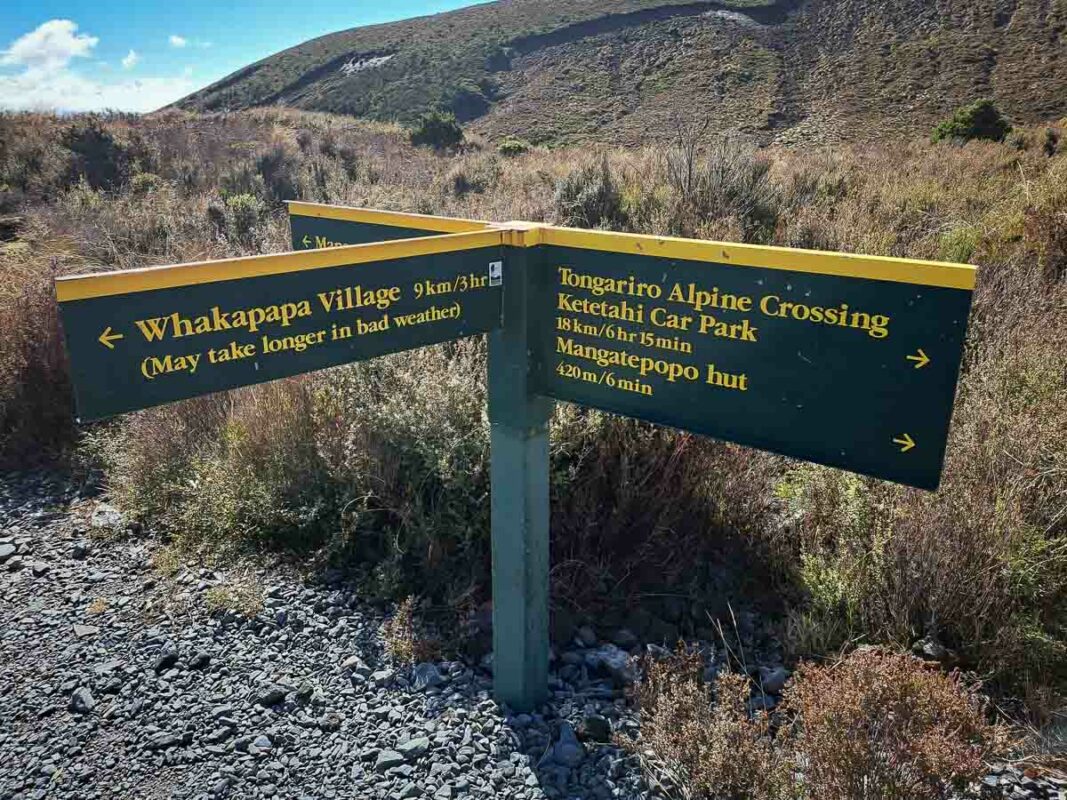
Day 2 – Mangatepopo to Oturere Hut
The second day is the most challenging, as it includes the Tongariro Alpine Crossing, but this is also the most scenic part of the park. The Alpine Crossing is known for its steep climbs, scree slopes, and unpredictable weather, so make sure to bring plenty of water, and keep snacks, warm clothes, and rain gear handy for when the conditions change.
The views were simply breathtaking, with emerald lakes, red craters, and panoramic vistas of the surrounding mountains.
Side Quest: Soda Springs
Just before the Devil’s Staircase is a turn-off to Soda Springs. This is a 10-minute walk each way to a small trickling waterfall from some springs above. Take a moment to fill up your water bottle and rinse off under the ice-cold falls, and ready yourself for the upcoming ascent!
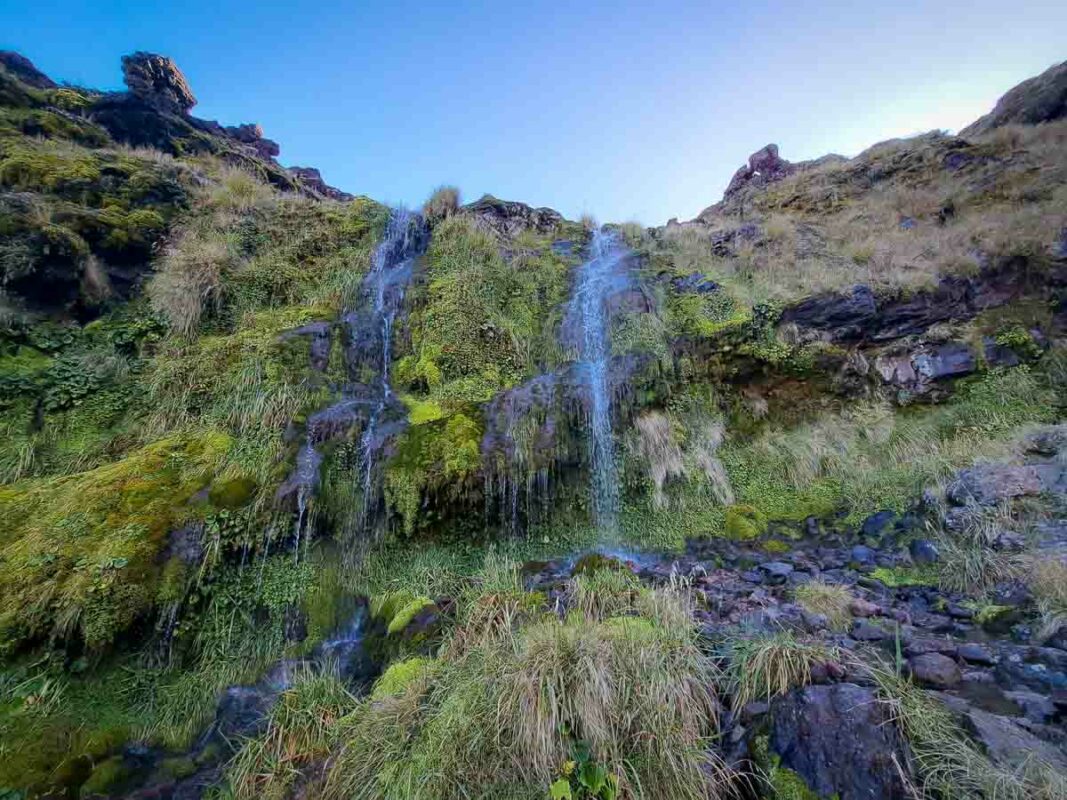
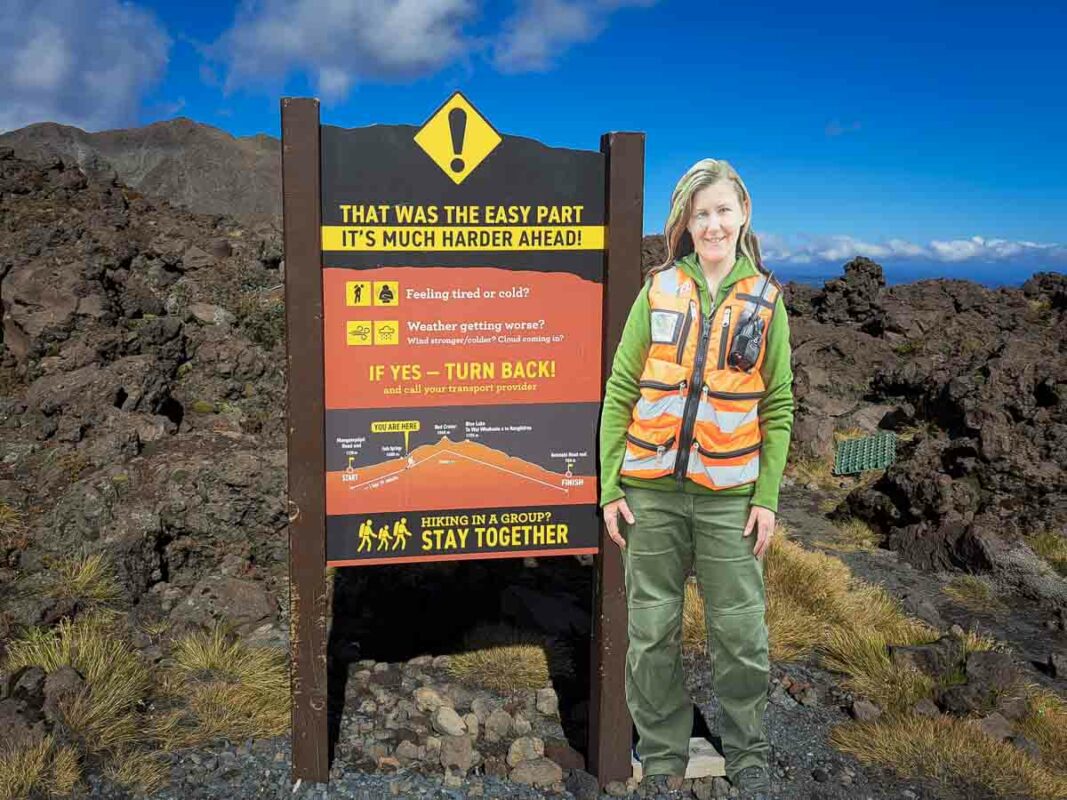
Side Quest: Mt Ngauruhoe and Mt Tongariro Summits (Not Recommended!)
Veering off the main track to tackle either the Ngauruhoe Summit (2hr return) or Tongariro Summit (1hr return) is no longer allowed, or at least not recommended. In 2017 signs have been removed and the paths were brushed over (source).
Why?
For one, these maunga are tapu (sacred places) and are considered as people, their ancestors, in Maori tikanga. The summits of the mountains are therefore the anscestor’s heads and standing on top of the summit is very disrespectful.
Another reason comes down to safety. Ngauruhoe is a 45-degree ascent of pure scoria. You take 2 steps forward and slide back just as far. If there’s anyone climbing above you, you’ll be donging loose rocks that come hurtling down towards you. In fact, a climber died just recently in 2022 after slipping down into the crater.
Should you climb?
Well, that’s up to you. Consider if you’re respecting the wishes of the local Iwi. Consider if it was your ancestral mountain. And consider if you do hurt yourself, the risk you’ll put others coming to rescue you.




Side Quest: Oturere Falls.
Drop your packs at the hut and take a 5-10 minute walk over the ride to Oturere Falls. We took some wine and chocolate and sat in the natural infinity pools, looking over the desert road, and watched the sunset.
Its also a great spot for a bird bath after 2 days in the hot dusty mountain conditions.
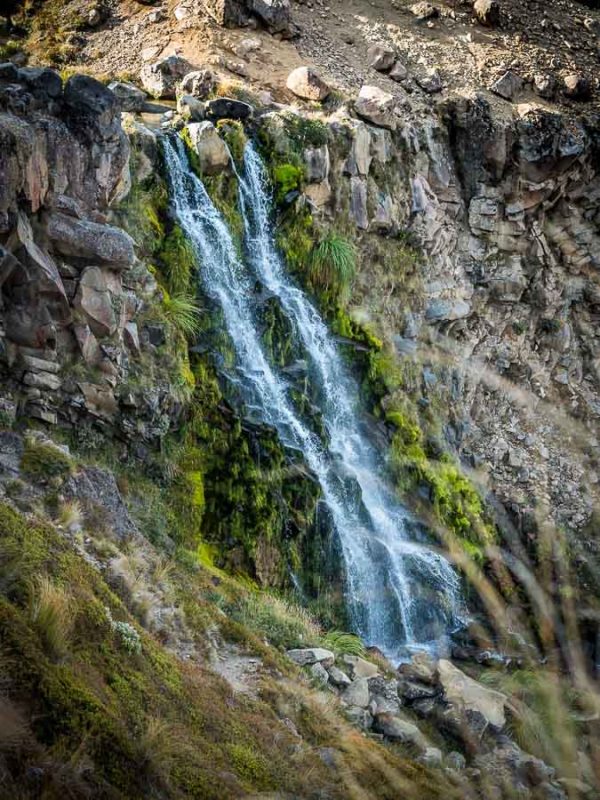
Day 3 – Oturere to Waihohonu Hut
The third day is much less demanding but still enjoyable, with views of the Kaimanawa Ranges and the Waihohonu Stream. The track was mostly flat and well-maintained, with occasional steep climbs and a nice section of walking through beech forest.
After about 3 hours of hiking, I reached the Waihohonu Hut, where I spent the night.



Side Quest: Ohinepango Springs
Once arrived at Waihohonu Hut you’ve got the whole afternoon to kill (it was only a 3hr trip after all). I had a quick swim in Waihohonu stream, and then a quick lunch before popping the hiking shoes back on to go check out Ohinepango Springs.
This is a 1 hr return trip from the new Waihohonu Hut.
Here, some of the clearest water you’ll ever see bubbles up from beneath the old lava flow. The stream comes from underground!
Note: Again, this is a very sacred place. Don’t swim in the stream

Side Quest: Historic Waihohonu Hut
Time: 20 min return from the new Waihohonu Hut, 10 min return from the Round the Mountain Track, 3 hr (6.3 km) return from Desert Road (State Highway 1)
Built in 1903/04, this was the first hut built in Tongariro National Park. It’s the oldest example of a typical early two-room mountain hut in New Zealand. Historic Waihohonu Hut
Day 4 – Waihohonu back to Whakapapa Village
The fourth and final day was the longest but fortunately very easy going as its mostly downhill walk from the Waihohonu Hut to the Whakapapa Village. The track followed the Waihohonu Stream and offered views of the Taranaki Falls and the Tongariro massif. After about 4 hours of hiking, you’ll end up back on Ngarurhoe Terrace and the Whakapapa Visitor Centre.
Side trip: Tama Lakes
Time: 20 min return to Lower Tama from the junction, 1.5 hr return to Upper Tama from the junction.
Tama Lakes, two infilled explosion craters, are named after Tamatea, the high chief of the Takitimu Canoe, who explored the area six centuries ago. The lower lake (at 1200 m), is 10 minutes from the junction. Volcanic debris is slowly washing in and filling the crater. The upper lake (at 1314 m) is a further 40 minutes up a steep ridge.
If you’ve got good weather I definitely recommend this side trip – you’ll also get a great view of where you’ve come from the last 3 days.


Tongariro Northern Circuit Weather (Be Prepared)
The weather in Tongariro National Park can be unpredictable and changeable, even in the summer months. It is important to check the weather forecast and prepare accordingly. The park is prone to sudden temperature drops, strong winds, and rain or snow, so you should bring warm and waterproof clothing, sturdy hiking boots, and a first aid kit.

Facilities in Each Hut
In this section, I’ll describe each hut in detail, what to expect, and watch out for when staying in these accommodations.
A couple of notes on hut etiquette:
- It’s expected in these great walk huts to use the gas cookers provided, rather than your own. Apparently, there was a fire recently in a hut from someone’s cooker exploding. So this measure is to avoid burning the (fancy) huts down.
- If you’re staying at the campsite, it’s expected that you don’t use the facilities indie the hut. These spaces are cramped as it is.
- The huts are Staffed during peak season. Wardens will check your bookings, and do a weather update in the evenings
Mangatepopo Hut
The Mangatepopo Hut is a basic but comfortable hut that offers bunk beds, cooking facilities, and toilets. It was built in 1974 and has a capacity of 20 people. It must be booked in advance on the DOC website. There is hand-pumped running water in the hut which is collected from the roof and is labeled boil before drinking. The hut is heated by a wood burner and there’s usually wood.
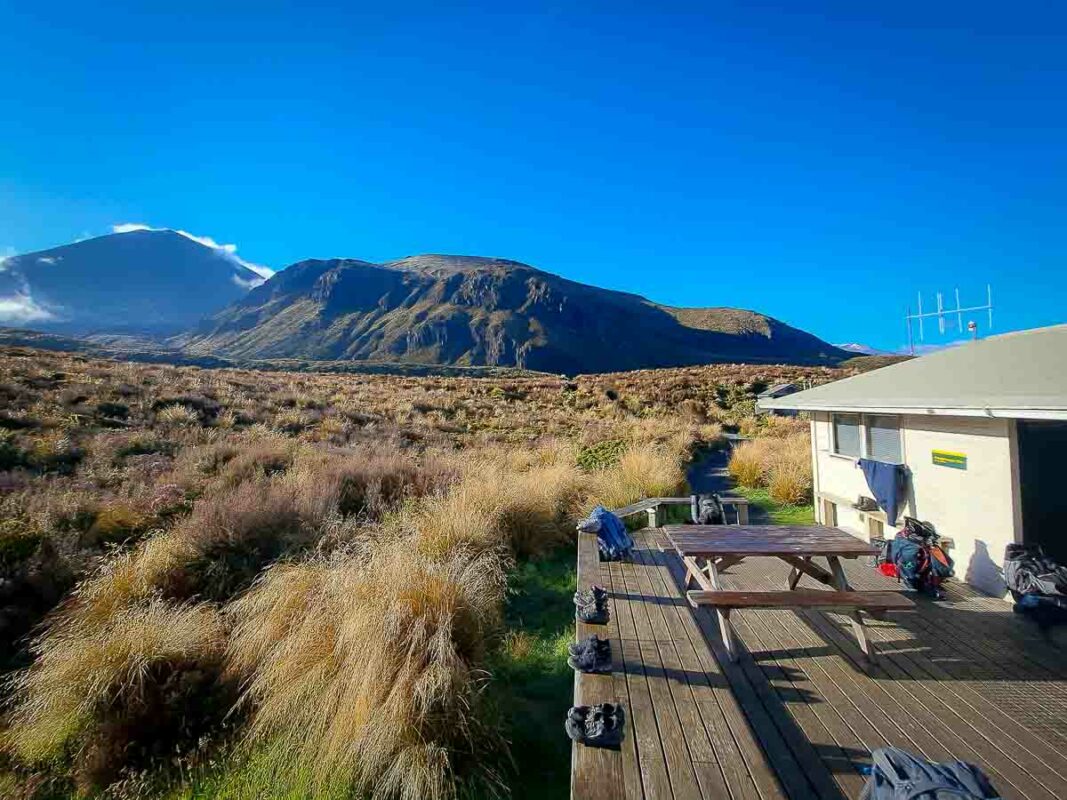
Oturere Hut
The Oturere Hut is an older hut that was built in 1970 and is the center point of the circuit. This small but cosy hut is perched on the side of the mountain adjacent the Oturere Falls.
It has a capacity of 26 people and operates on a booking system, which can be done online through the Department of Conservation website. The hut has running water, a gas stove, and a wood burner for heating.
There is the option for tenting if desired, but do note this is the center point of the circuit with some trampers coming from either end skipping the other two huts and just staying here at Oturere, so it can be busy.
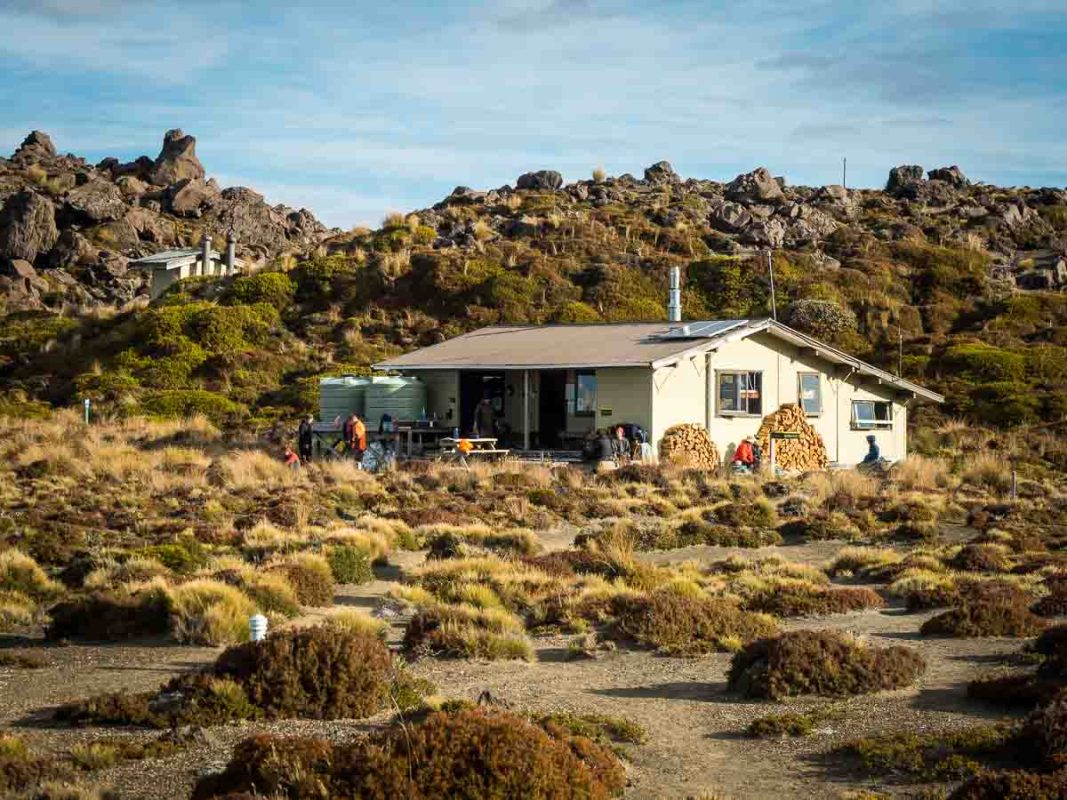
Waihohonu Hut
The Waihohonu Hut (3) is the newest and largest hut on the Tongariro Northern Circuit, with a capacity of 28 people. It was built in 2010 and offers bunk beds, cooking facilities, long drop toilets, and a large communal area. It also has a wood burner for heating and a gas stove for cooking.
I say Waihohonu 3 because there were 2 hut precceding this. Waihohonu the first was built in 1904 and is a historic site preserved so you can visit it on your last day of the circuit. Waihohonu 2 was built in 1968 and then demolished in 2013 once the current itteration became operational.
There is hot and cold running water in the hut for cooking and cleaning up, but it’s recommended you boil or purify before drinking.
Keep in mind that the huts are basic and do not provide any bedding or cooking equipment, so you will need to bring your own sleeping bag, and cooking gear. It’s also important to carry out all your rubbish and leave the huts clean and tidy for the next hikers.
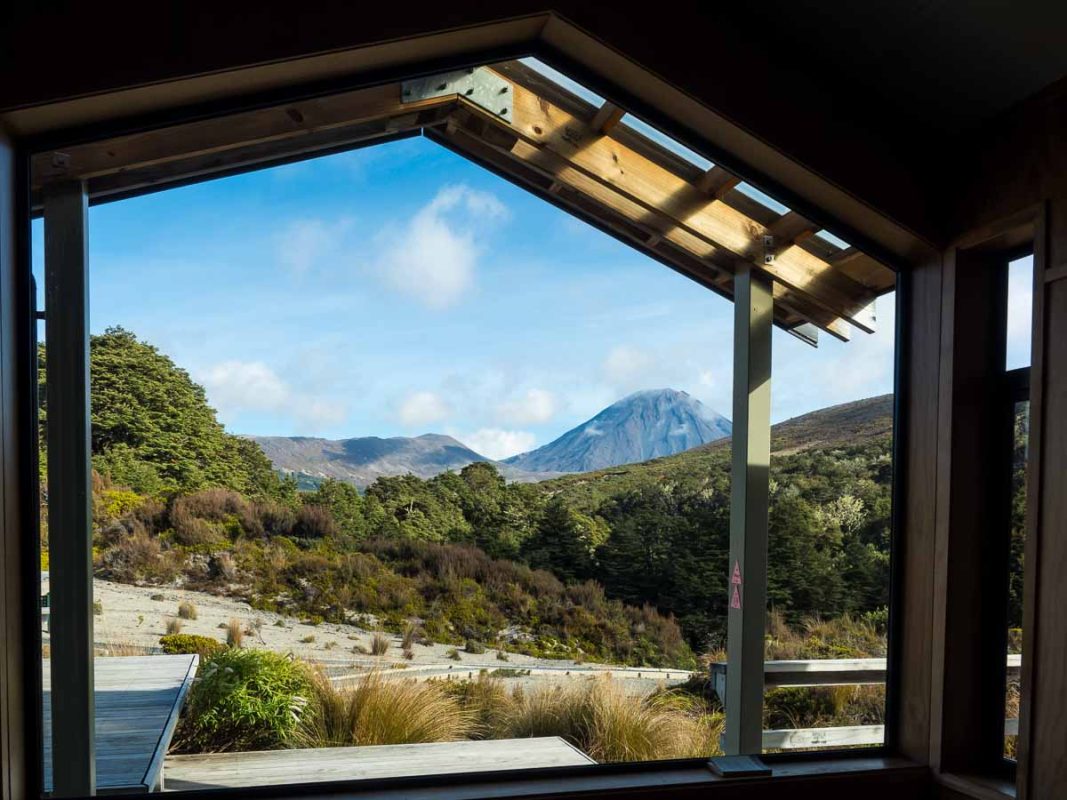
How Hard Is The Tongariro Northern Circuit
The difficulty of the Tongariro Northern Circuit depends on a few factors, including distance, duration, direction, weather, changing conditions, and terrain.
In general, as a Great Walk hike, it is approachable to people of most ages and fitness levels. The facilities are good – although probably a little sub par for other Great Walk hikes.
By taking the full 4 days the distiances and diffiulty becomes much easier and more manageable.
Read More: You can read my full breakdown of how hard the Northern Circuit is in this post here.
| Route | Duration | Difficulty | Description |
|---|---|---|---|
| 4-day Circuit | 4 days | Easy/Moderate | Steep climb on the first day, longest day on the second, climb up to Red Crater on the third, easy walk on the fourth |
| 3-day Circuit | 3 days | Moderate | Short climb on the first day, longest day on the second, easy walk on the third |
| 2-day Circuit | 2 days | Hard | Steep climb on the first day, longest day on the second |
| Alpine Crossing | 1 day | Moderate | Steep climb up to Red Crater, challenging descent |
| Southern Circuit | 6 days | Hard | Remote and rugged, back country huts |
What to Pack (My Specific Recommendations)
Packing the right gear and equipment is essential for a successful Tongariro Northern Circuit hike. Here are some items that you should consider bringing. A lot of this is pretty general, but I’ve added a few personal recommendations and lessons learned as well:
- Backpack:
A sturdy backpack that fits well and can carry all your gear. I took an Osprey Atmos
65L pack and that was perfect. - Hiking boots:
Proper hiking boots with good ankle support and traction on steep and slippery terrain. Honestly, these days I lean much more to trail shoes than boots. They are much more comfortable and lightweight. I did this hike the first time in a pair of Altra Lone Peaks, and the next in some robust Hiking Jandals. - Clothing:
Dress in layers and bring warm and waterproof clothing, including a rain jacket, thermal base layers, fleece or down jacket, hat, gloves, and warm socks. A Merino base layer is a must!
I wore a Icebreaker BodyFit base layer which was the perfect option to wear under another layer in the cold, or by itself when the sun comes out. - Rain Jacket.
The weather on the Crossing and Circuit changes every 5 minutes. I forgot my rainjacket and got wrecked on our last day when the weather turned. I normally pack the Macpac Copland Raincoat. - Food and water:
Bring plenty of high-energy snacks, such as nuts, dried fruit, and energy bars, as well as a refillable water bottle or hydration system. - Sleeping bag:
A warm and lightweight sleeping bag rated for below-freezing temperatures.
Hot tip – grab a cheap single fitted sheet from Kmart to prevent sticking to the vinyl hut mattress. Warmer too! - Cooking equipment: If you plan to cook your own meals, bring a stove, fuel, cooking pot, utensils, and food. Get cheap gear from Aliexpress (can’t fly with gas)
- First aid kit: A basic first aid kit with essentials such as bandages, antiseptic, pain relievers, and blister treatment.
- Map and compass: A detailed map and compass or GPS device to navigate the trail. Download maps or rent a PLB from Macpac?
- A good lightweight camera
When I walked the circuit I took my super lightweight Olympus OMD EM5 MkII with M. Zukio 12mm – 40mm PRO lens. Great camera, but getting a bit old now. If I did it again I’d recommend something like the Fujifilm XT4 or similar. OR, check out my full guide to hiking cameras here. - Flashlight or headlamp,
Go Black Diamond. Go USB rechargeable. They’ve served me so well and this one is a goodie
Keep in mind that you will need to carry all your gear and food with you during the hike, so pack light and only bring what you need. It’s also a good idea to check the Department of Conservation website for a full list of recommended gear and equipment.

5 Tips For A Good Time On The Northern Circuit
Ok, we’ve talked about what the huts are like, what to pack, etc, etc. But here are 5 of my key recommendations from my two trips around the circuit (so you don’t make the same mistakes I did)
- Pack Wine and a pack of cards
You’ll have heaps of free time on this walk. Hiking for 3 – 5 hours each day. Make friends at the huts. Sit on top of Oturere falls and enjoy the experience. - Buy A Fitted Sheet
$13 at Kmart will turn a crappy hut mattress into a luxury AirBnB escape. Ok, not wuite but it’s a whole lot more comfy than getting stuck to the mattress in glue made up of your own sweat at 2am in the morning. - Do All The Side Quests:
I’ve made sure to explain all the fun extras along the way eariler in this article. You’ve got the time so i totallly recommend checking these all off to get the full Tongariro experience. - Pack For The Extreme Heat, and Cold.
These are alpine areas and the weather is brutal. You can get sunburnt while being freezing cold (always wear some high SPF suncrean) and you can get into a hypothermia situation real quick. So pack for all extremes.
- Getting Bookings. (The Great Walks reservations site)
This is a great walk of New Zealand and as a result, it books out real fast. You need to book, and in my opinion, doing the circuit in huts is waaay more enjoyable than staying in tents, so book early to get a spot.
If you miss out, try the great walks vacancy notification app.
Northern Circuit FAQ:
Q1. What Town is the Tongariro Northern Circuit Near?
The Tongariro Northern Circuit is located in Tongariro National Park, which is situated in the central North Island of New Zealand. The nearest town to the park is National Park Village, which is located 20 km (12 miles) southwest of the Whakapapa Village where you start and end the hike.
Q2. Is the Northern Circuit the Same as the Alpine Crossing?
No, the Tongariro Northern Circuit includes most of the Tongariro Alpine Crossing as well as other scenic sections of the park. The Alpine Crossing is a one-day trek that covers the most popular section of the park and offers stunning views of Mount Ngauruhoe (also known as Mount Doom in the Lord of the Rings movies).
Q3. How Hard is the Tongariro Northern Circuit?
The Tongariro Northern Circuit is a challenging hike that requires good fitness, proper equipment, and careful planning. The track covers 43.1 km (26.8 miles) and includes steep climbs, scree slopes, river crossings, and unpredictable weather. It is recommended for intermediate to experienced hikers who are in good physical condition.
You can read more on how hard the circuit is, and how to best prepare for it here.
Sources:



